Branch Vessel Graft Method and Delivery System
a branch vessel and vascular system technology, applied in the field of medical devices and procedures, can solve the problems of repositioning the stent-graft, failure to provide the desired control, and little room for error in placemen
- Summary
- Abstract
- Description
- Claims
- Application Information
AI Technical Summary
Problems solved by technology
Method used
Image
Examples
Embodiment Construction
[0049]The various drawings illustrate several embodiments and aspects of branch graft deployment systems according to the present invention.
[0050]The prior art system described in the background has many common elements of the general structure and function of endoluminal grafting systems for branched anatomincal conduits according to the present invention. Several distinctions will illustrate the novel improvements therein.
[0051]The primary graft or main stent-graft and branch graft deployment system 70 of FIGS. 2A-D is similar to the system 10 of FIGS. 1-1D except for various key features that would enable greater control, trackability, and maneuverability for both the primary and branch grafts even after partial deployment of the primary graft 72. As in system 10, the system 70 can include a deployed bifurcated primary graft 72 having a port or branch graft opening 75 or additional ports 77 as needed, a catheter system 76 including a retractable primary sheath, an outer tube with...
PUM
 Login to View More
Login to View More Abstract
Description
Claims
Application Information
 Login to View More
Login to View More - R&D
- Intellectual Property
- Life Sciences
- Materials
- Tech Scout
- Unparalleled Data Quality
- Higher Quality Content
- 60% Fewer Hallucinations
Browse by: Latest US Patents, China's latest patents, Technical Efficacy Thesaurus, Application Domain, Technology Topic, Popular Technical Reports.
© 2025 PatSnap. All rights reserved.Legal|Privacy policy|Modern Slavery Act Transparency Statement|Sitemap|About US| Contact US: help@patsnap.com



